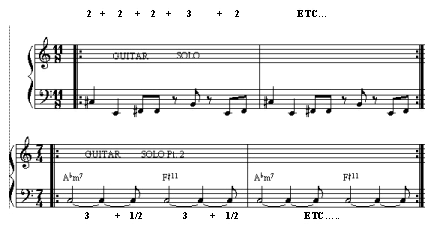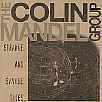In the last installment we dealt with simple odd meter. As previously discussed, all odd meter figures can be broken down into smaller groups of two's and three's (Ex. A bar of 5/4 could be broken down as 2+3 or 3+2). The examples in Part One dealt with odd meter that was composed with the quarter note being the predominant pulse. Even less common in pop music, but quite common in my own music, is odd meter where the eight note and the sixteenth note is the basic pulse. This usually exists in much more complex figures than the quarter note type of odd meter figures, and is often longer. In the case of sixteenth notes, they are splitting a beat into four parts instead of two, usually resulting in much larger time signatures.
We will look at some eight-note examples, and in Part Three begin 16th note studies off Odd Meter. Remember: depending on how the bar is phrased they can always be broken down in to groups of two's and three's. This method of breaking them down like this is far more difficult when sixteenth notes groupings are involved.
In this installment, we will look at some odd meter examples where the eight note is the basic pulse. In example one (from my latest release), the meters change literally every bar, however, this is executed in a way that sounds as natural as any style of music. The changing of time signatures is somewhat like breathing. When played correctly not only does it not sound as if odd meter is being played, but it creates a bass line and other parts as well, due to the way things are written. These bars are short and are not written in the usual 4/4 due to the phrasing of the example.
Example 1: From the CD "Strange and Savage Tales" - Song: "The End Of Childhood Summers"

In example one, we see the same kind of thing as we did in Part One, where the predominant pulse was the quarter note. Here it is the eight note, which, by nature implies a different feel and tempo range. The beaming of the notes in each bar already subdivides itself somewhat into what the breakdown of 2's and 3's are. This example is a second guitar part that actually creates the effect of more than one part if played fluidly. In example one, each bar is actually a chord figure that should be played smoothly with the notes ringing into each other.
If one were soloing over a pattern such as this (and this is only a fragment of a large part), until these meters and phrases are natural as anything else you improvise over, again the use of breaking things up into 2's and 3's may help. Drummers definitely work at these kind of things that way. A good thing to do is use a sequencer or even a four track with possibly a click track, and practice simply just improvising over one time signature, such as 7/8. Over a period of time, this becomes very normal. Make sure in whatever rhythm track you are using to practice this, that you subdivide the 7/8 in as many ways as possible. Just reversing the first bar in example one, will totally change the feel and phrasing.
We will look at one more example of odd meter with eighth notes, before we move on to
the next installments use of odd meter with the sixteenth note as your underlying pulse. It is very important that one is comfortable with these type meters in succession. First with the quarter note as the pulse, then the eight note, and finally the sixteenth note. Each one gradually is more difficult, has more possibilities, and takes longer to get used to playing.
Below in Example Two is the solo section to the guitar solo on "Count Me Out" from the "Strange and Savage Tales" CD. It makes use of both the eight-note pulse and then the quarter note pulse with odd meters. On the record on this particular tune I made my phrases fit exactly the meters they were in, as opposed to playing over the barline. This is the only real type of groove, or repeated figures on the CD, instead of having a series of complex changes. The combination of eight and quarter note pulses gives a nice feel of breathing to it, which is the intent behind all of my own odd meter writing.
My own writing process consists of writing all the music in my head first, and gives no thought to what it might look like on paper. That should be the way it is composed, as often musicians who do use it, sound quite contrived. It is simply a matter of naturally feeling it, or through listening and practice, when hearing these types of figures becomes as normal as any other type of more common time feels.
Example 2: From "Strange and Savage Tales" - "Count Me Out" guitar solo

Although the bars of 7/4 can easily be broken up as a whole into groups of two's and three's like all odd meter bars, the _ is used as the actual chords are syncopated, with each getting 3 1/2 beats, dividing the bar evenly in half. So if one were to follow the chord changes within the bar improvising on each of the two alternating chords, the only sensible way to count them would be as 1,2,3, & 1,2,3, & which makes a total of 7 quarter notes.
To effectively establish the harmony in your improvisation, at some points in your solo, this is the most logical way to count the bar out. It is a slight deviation from the normal two and three method of breaking an odd meter bar up. In this particular recording, the drums could easily be broken up the traditional way, as it does not totally have to follow the harmony.
In Part Three of Odd Meter Guitar, we will look at sixteenth note odd meter usage. It is important that one learns and gets used to these type of time feels in succession. Eight note odd meter can have many varieties, such as 9/8/,10/8/, 11/8 and so on. Be sure to find an accurate way (preferably a sequencer) to practice these time signatures, and try to find the many combinations and feels that they can be broken into. Happy practicing!
The late Colin Mandel was a guitarist out of Los Angeles and a graduate of the Berklee College Of Music.
During his career he had been featured as new talent in Guitar Player and Guitar World Magazines.
His instrumental CD is entitled "Strange and Savage Tales...".
